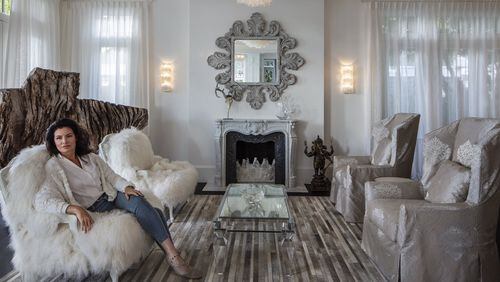MEDINA, Wash. — Piece by piece, room by room, Lisa outfitted her family’s entire Medina home like a dogged detective on a complicated case: gathering evidence, summoning expert witnesses and even re-creating the scene of design.
And goodness — what a case.
Lisa and her husband, Sebastian, live with their three children (and a nine-critter menagerie) in a dazzling showpiece of a home overlooking Lake Washington. Before moving in, they launched an ultra-extensive 2 1/2-year remodeling project (helmed by Stillwell Hanson Architects and builder Schultz Miller). “There was not a stone unturned,” Lisa says. “I don’t think there was one piece of drywall untouched.”
Given that expansive blank canvas, others might have drawn on professional intervention. Lisa did not. And here’s what her do-it-yourself interior-design investigation ultimately proved: This is hard.
“I have no background in design. I guess I had so many ideas myself, I really wanted it my way,” she says. “I did every room; it’s just a full-time job — plus with kids. I’d never do it again. It was really an absurd amount of work. I worked solid every single day — a good solid year thinking about it every day.”
Also in evidence, along with intense time and effort: trust.
“I did almost everything online — hours and hours of searching,” she says. “I worked with antiques dealers in New York and Paris; I didn’t purchase anything from Seattle. I bought everything sight-unseen. Everything was a surprise when it showed up — I only touched some fabrics. I can’t think of a piece I went to a store and found.”
There are a couple of ways to make this approach work: reactively (haul things around haphazardly, and back-breakingly, until they look right), or proactively, with purpose. Lisa is not a reactive DIY designer.
“I would just sit here and visualize the placement of everything,” she says. “Everything had a place when it arrived. I had it all planned. I did a lot of taping, or Schultz Miller would do a mock-up. I bought all the lights online, and they’d send detailed pictures. I was new to this type of detail. We’d hang a box to mock it up — we went an extra step. We made little cardboard things of everything in here.”
Her visionary visualization paid off radiantly, in a bright, enlightened palette reminiscent of the family’s previous home in Miami: whites, silvers and gray, with occasional “yowza” pops of gold:
— Right inside the entry, past the life-size Serge Roche statue “the UPS guy calls the Starbucks lady,” a glowing white wall of box niches frames a grand piano. “I completely copied Kelly Hoppen and Sara Story, my favorite designers; you can call it inspiration. I think it works.”
— From there, “The Phoenix,” a looming golden statue, rises near the great room’s wall of lake-facing windows. “It’s one of my favorite pieces, and the last, last purchase,” Lisa says. “I just wanted to make sure it’s not too much.”
— In the kitchen, Lisa says, “A friend in Miami designed the stove hood and gave me the idea to wrap it in stone.” (Lambert Stone handled the home’s stone work, including the fabrication of the hood, and the master bathroom.) Working with Northwest Custom Cabinets, Lisa “went over all the cabinetry drawings and did every little detail. I designed the handles. If they’re not perfectly measured, the glass fractures. It’s delicate — a lady’s kitchen.”
— Under a fabulous, formidable mesh light, the massive dining-room table (ringed by vintage Milo Baughman chairs Lisa recovered with a fabric she chose) came from their home in Fall City, she says: “It’s huge, like giants lived there. Movers hate me.”
— Upstairs, past a stunning and delicate silver-leaf piece by New York artist Rachel Lee Hovnanian, individual, removable fabric pillows inspired by a Restoration Hardware photo (but in “the right color white”) connect to plushly cover the walls of the master bedroom. “Everyone calls it my padded room,” Lisa says.
— In the adjoining soaring-ceilinged master bath, a claw-foot tub rests on Ann Sacks tiles, along with a super-reflective vanity cabinet Lisa designed herself. “It took forever to get perfect,” she says. “I made all the decisions, found all the handles. We went three months without vanities waiting for the silver foil on the back of the glass.”
“Do-it-yourself” rarely comes easily, of course — but in the best cases (and this is one of those), a whole lot of “doing” leads to a blessed sense of “yourself.”
“Designers do this all the time, but they’re better. I thought it would be much easier. It takes a lot of investigating,” Lisa says. “A friend of mine is doing her house and had Nate Berkus do it — she was shopping in New York with him and having fun, and I was in the fabric store for the 1,000th time with fuzz all over me. It is your house — you want it to feel like yours.”






